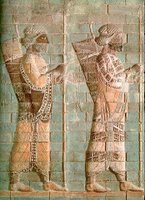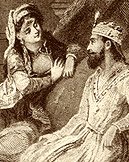The Persian Immortal Army

The Persian Immortals were a Persian elite Royal Guard active during the Achaemenid Period. Much of our information about the Immortals is from the depictions of the Greek "historian" Herodotus during the Persian Wars. He first mentions the Immortal army in his description of the battle of Thermoplyae (480 BCE), where he calls them the Athanatoi or the Ten Thousand. He describes them as :
a body of picked Persians under the leadership of Hydarnes, the son Hydarnes. This corps was known as the Immortals, because it was invariably kept up to strength; if a man was killed or fell sick, the vacancy he left was at once filled, so that the total strength of the corps was never less -and never more- than ten thousand.
Of all the troops in Persian army, the native Persians were not only the best but also the most magnificently equipped; their dress and armor I have mentioned already, but I should add that every man glittered with the gold which he carried about his person in unlimited quantity. They were accompanied, moreover, by covered carriages full of their women and servants, all elaborately fitted out. Special food, separate from that of the rest of the army, was brought along for them on dromedaries and mules. (Histories 7.83; tr. Aubrey de Selincourt)
Its been said that the regiment accepted only Median or Persian applicants. About the uniform and the equipment of the Immortals Herodotus mentioned that:
The dress of these troops consisted of the tiara, or soft felt cap, embroidered tunic with sleeves, a coat of mail looking like the scales of a fish, and trousers; for arms they carried light wicker shields, quivers slung below them, short spears, powerful bows with cane arrows, and short swords swinging from belts beside the right thigh. (Histories 7.61; tr. Aubrey de Selincourt)
Herodotus mentions that in the Thermoplylae these corps played a major role. The Greeks had blocked a narrow road along the coast and prevented the Persians from invading Greece. The Immortals however, made a detour and attacked the Greeks at the rear. The Immortals are also mentioned during the second year of the war (479 BCE), when they remain in Greece under the commandment of Mardonius.
As mentioned previously the Immortals are depicted only through the views of Herodotus. No other source mentions the name of this group of a Persian elite troop. There implications however, can be found on the coloured glazed bricks and carved reliefs at the Achaemenian capitals, such as the Palace of Artaxerxes at Susa and Persepolis. They are often represented standing stiffly at attention, each soldier's wooden spear with its silver blade and pomegranate insignia held upright and resting firmly on his toe. They wore elaborate robes and much gold jewellery. An elite 1,000 of the Immortals were further distinguished by having gold pomegranates on their spears.


